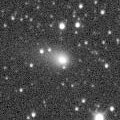
|
It brightened up to 8.5 mag on Oct. 25 (Marco Goiato). It is expected to reach to 4 mag in February. It is not observable now. It was about 9 mag in the SOHO images (Dec. 1, Michael Mattiazzo). It will appear in the morning sky again at 7 mag in late December. Then it keeps observable in the excellent condition long time around the highlight until spring.
Date(TT) R.A. (2000) Decl. Delta r Elong. m1 Best Time(A, h)
Dec. 13 16 7.32 -19 59.4 2.195 1.292 17 7.4 5:28 (293, -2)
Dec. 20 16 5.27 -19 54.7 2.077 1.259 25 7.1 5:32 (298, 4)
|

|
It was expected to reach up to 7 mag and to be observable in good condition in winter. However, this comet has not been observed since 1986. It was not detected, fainter than 20 mag on Dec. 1 (Takaaki Oribe). It seems much fainter than expected. The condition of this apparition is good. It keeps observable for a long time until 2009 early summer both in the Northern Hemisphere and Southern Hemisphere.
Date(TT) R.A. (2000) Decl. Delta r Elong. m1 Best Time(A, h)
Dec. 13 22 28.70 -5 0.7 0.880 1.148 75 7.1 18:19 ( 29, 46)
Dec. 20 22 55.44 -1 48.7 0.874 1.149 76 7.1 18:22 ( 32, 49)
|

|
First return of a bright new periodic comet discovered by SOHO spacecraft in 2003. Now it was re-discovered by STEREO-B spacecraft. It must have been brightening very rapidly in the evening sky from September to early December. But it was not observed on the ground. Now it is too close to the sun, and not observable. However, it will appear in the morning sky at 8 mag in early January. Then it keeps observable in good condition while fading gradually.
Date(TT) R.A. (2000) Decl. Delta r Elong. m1 Best Time(A, h)
Dec. 13 19 15.05 -28 46.8 0.536 0.555 26 7.8 18:19 ( 55, -1)
Dec. 20 18 35.72 -26 3.3 0.462 0.535 10 7.2 18:22 ( 67,-12)
|
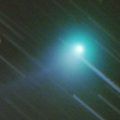
|
It reached to 6.3 mag in September in the southern sky (Sept. 4, Marco Goiato). Now it is still bright as 8.8 mag (Nov. 26, Carlos Labordena). It keeps locating in the evening low sky until the end of 2008 when it fades out down to 10 mag. Then it turns to appear in the morning sky, and it keeps observable in the northern sky after that while fading gradually. In the Southern Hemisphere, it will never be observable again.
Date(TT) R.A. (2000) Decl. Delta r Elong. m1 Best Time(A, h)
Dec. 13 18 14.80 13 59.8 2.239 1.604 39 9.3 18:19 ( 98, 13)
Dec. 20 18 28.32 17 0.6 2.290 1.682 41 9.6 18:22 (103, 12)
|
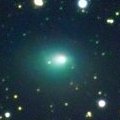
|
Brightening very rapidly, faster than expected. It is already so bright as 10.0 mag (Nov. 30, Maik Meyer). Strongly condensed and easy to see. It is expected to reach to 8 mag in 2009 summer. Because it moves in the northern sky, it keeps observable until it becomes brightest in the Northern Hemisphere.
Date(TT) R.A. (2000) Decl. Delta r Elong. m1 Best Time(A, h)
Dec. 13 21 55.27 52 5.9 3.463 3.695 95 10.1 18:19 (139, 64)
Dec. 20 21 55.85 49 28.1 3.516 3.661 90 10.1 18:22 (130, 60)
|
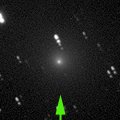
|
It has brightened much faster than expected. It was so faint as 20 mag in early September, and it was still faint as 16.1 mag on Nov. 1 (Ken-ichi Kadota), however, it became so bright and visible visually at 12.2 mag on Nov. 16 (Juan Jose Gonzalez). Now it is bright as 11.0 mag and looks very large (Nov. 29, Michael Jager). The CCD image detected its faint coma up to 10 arcmin. It will reach up to 10 mag in January. Then it keeps observable in good condition and visible visually for a long time until next spring.
Date(TT) R.A. (2000) Decl. Delta r Elong. m1 Best Time(A, h)
Dec. 13 3 17.85 17 20.6 0.590 1.525 150 11.0 21:48 ( 0, 72)
Dec. 20 3 19.87 16 37.5 0.591 1.501 143 10.7 21:22 ( 0, 72)
|
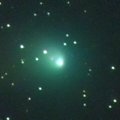
|
Now it is bright as 10.8 mag (Dec. 2, Ken Harikae). It keeps observable in good conditioni as bright as 11 mag until January. Then, it keeps observable, visible visually, brighter than 14 mag for a long time until 2009 May.
Date(TT) R.A. (2000) Decl. Delta r Elong. m1 Best Time(A, h)
Dec. 13 6 28.73 59 53.8 1.775 2.617 141 10.8 1:02 (180, 65)
Dec. 20 6 21.12 58 55.5 1.785 2.646 144 10.9 0:27 (180, 66)
|
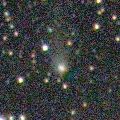
|
It brightened up to 11.5 mag in summer (Aug. 4, Marco Goiato). It keeps bright at 12 mag for a long time until 2009 spring. However, it is not observable in the Northern Hemisphere now. It will appear in the northern sky again in 2009 autumn, but it will be fainter than 15 mag and will keep locating very low after that. In the Southern Hemisphere, it keeps observable for a long time until it fades out, although it becomes low in autumn.
Date(TT) R.A. (2000) Decl. Delta r Elong. m1 Best Time(A, h)
Dec. 13 17 1.23 -62 3.9 3.353 2.662 39 12.4 5:28 (327,-31)
Dec. 20 17 18.87 -64 7.3 3.333 2.671 41 12.4 5:32 (330,-30)
|
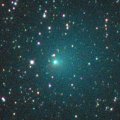
|
It reached up to 8.5 mag in September (Sept. 24, Juan Jose Gonzalez). Diffuse object expanding a large coma. It is still bright as 11.0 mag (Dec. 1, Marco Goiato). In the Northern Hemisphere, it locates extremely low now. Although it will be getting higher slowly after this, it will be fading rapidly. However, it keeps observable in the evening sky until it becomes fainter than 18 mag early 2009.
Date(TT) R.A. (2000) Decl. Delta r Elong. m1 Best Time(A, h)
Dec. 13 0 32.21 -22 21.1 1.505 1.885 96 12.5 19:03 ( 0, 33)
Dec. 20 0 43.85 -20 14.3 1.614 1.934 93 13.1 18:47 ( 0, 35)
|
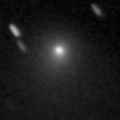
|
It reached to 10.9 mag in May (May 11, Marco Goiato). Now it is fading slowly. It has faded down to 12.0 mag on July 21 (Alexandre Amorim). Now it is appearing in the morning sky after a long blank. Now it is about 13 mag (Nov. 30, H. Sato). It keeps bright as 12-14 mag for a long time after this until 2009 summer.
Date(TT) R.A. (2000) Decl. Delta r Elong. m1 Best Time(A, h)
Dec. 13 15 17.64 2 15.3 3.919 3.221 39 12.8 5:28 (283, 21)
Dec. 20 15 27.37 3 3.3 3.889 3.257 44 12.9 5:32 (286, 26)
|

|
Already bright as 13.5 mag, and visible visually (Oct. 7, Alan Hale). It is extremely low in the Northern Hemisphere now, but observable in good condition in the Southern Hemisphere. It is expected to brighten up to 10 mag from late 2009 to early 2010. Because the comet moves in the southern sky for a long time, it keeps impossible or very hard to observe in the Northern Hemisphere until 2009 September. But after 2009 October, it is observable at 10 mag for a while in good condition. In the Southern Hemisphere, it keeps observable for a long time while brightening until 2009 June when it brightens to 11 mag. But it becomes unobservable around and after the brightest time.
Date(TT) R.A. (2000) Decl. Delta r Elong. m1 Best Time(A, h)
Dec. 13 5 56.11 -54 17.6 3.594 3.922 102 13.0 0:29 ( 0, 1)
Dec. 20 5 49.24 -54 10.2 3.533 3.865 102 12.9 23:50 ( 0, 1)
|

|
An large outburst occured on Sept. 21, and it became so bright as 11.3 mag (Juan Antonio Henriquez Santana). The total brightness reached up to 10.3 mag in October (Oct. 11, Maik Meyer). It keeps bright as 11.0 mag still now (Dec. 2, Ken Harikae). Now the diameter is over 5 arcmin, looks very large and diffuse. Albert Sanchez reported the central nucleus was in small outburst on Dec. 11.
Date(TT) R.A. (2000) Decl. Delta r Elong. m1 Best Time(A, h)
Dec. 13 8 16.80 23 4.0 5.301 6.087 139 13.5 2:50 ( 0, 78)
Dec. 20 8 14.37 23 9.1 5.236 6.089 147 13.5 2:20 ( 0, 78)
|
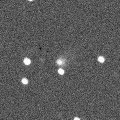
|
Now it is 14.4 mag, and visible visually (Nov. 30, Alan Hale). It locates near by Polaris until December, and observable all night. It will brighten gradually after this, and reach to 9-10 mag in 2009 June. In the Northern Hemisphere, it keeps observable in good condition until May when it becomes brightest. But it will never be observable again after that. In the Southern Hemisphere, it is not observable until 2009 April. But after that, it will be observable while fading gradually.
Date(TT) R.A. (2000) Decl. Delta r Elong. m1 Best Time(A, h)
Dec. 13 0 20.92 87 41.0 2.278 2.822 113 13.8 18:51 (180, 37)
Dec. 20 0 22.80 85 53.7 2.195 2.745 113 13.6 18:26 (180, 39)
|
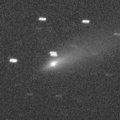
|
It reached up to 9.6 mag in summer (Aug. 2, Juan Jose Gonzalez). Now it is fading. It has already faded down to 12.5 mag (Nov. 22, Seiichi Yoshida). It keeps observable and fading in the morning sky after this. It keeps brighter than 14 mag and visible visually until the end of 2008. In the Southern Hemisphere, it keeps extremely low, or under the horizon, so it will not be observable.
Date(TT) R.A. (2000) Decl. Delta r Elong. m1 Best Time(A, h)
Dec. 13 13 3.89 26 36.3 1.996 2.063 79 13.6 5:28 (278, 61)
Dec. 20 13 15.00 27 0.5 1.978 2.113 83 13.8 5:32 (282, 66)
|
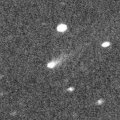
|
Now it is 15.3 mag (Nov. 30, Yuji Ohshima). It will brighten rapidly after this. It will be observable at 12-13 mag for a long time from January to July in 2009. But actually, it seems to be fainter than this ephemeris.
Date(TT) R.A. (2000) Decl. Delta r Elong. m1 Best Time(A, h)
Dec. 13 9 58.70 17 6.5 2.055 2.630 115 14.2 4:31 ( 0, 72)
Dec. 20 10 1.62 17 0.9 1.951 2.606 121 14.0 4:07 ( 0, 72)
|
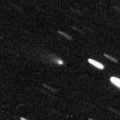
|
Now it is 14.6 mag (Nov. 19, Alan Hale), already visible visually. It will be brightening gradually after this, and reach to 12-13 mag in 2009 winter and spring. In the Northern Hemisphere, it keeps observable for a long time until 2009 May.
Date(TT) R.A. (2000) Decl. Delta r Elong. m1 Best Time(A, h)
Dec. 13 22 4.92 -16 57.1 1.661 1.551 66 14.4 18:19 ( 30, 33)
Dec. 20 22 20.01 -15 2.6 1.668 1.505 63 14.3 18:22 ( 35, 33)
|

|
An outburst occured in 2008 February, and it brightened up to 16.0 mag (Feb. 28, Mt. Lemmon Survey) although it was predicted to be so faint as 19 mag. It had been reported brighter than predicted until early April. However, it returned to be so faint, fainter than 18 mag, after mid April. Although it has not beeb observable for a while, now it appeared in the morning sky again. Now it is 14.8 mag, brightening as expected (Dec. 2, Ken-ichi Kadota). It will be bright at 9-10 mag for a long time from spring to autumn in 2009.
Date(TT) R.A. (2000) Decl. Delta r Elong. m1 Best Time(A, h)
Dec. 13 14 40.13 -11 47.3 2.869 2.208 40 14.8 5:28 (301, 19)
Dec. 20 14 54.93 -12 50.5 2.774 2.167 43 14.6 5:32 (305, 22)
|
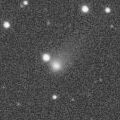
|
It brightened up to 12.7 mag in spring (Apr. 12, Marco Goiato). However, it has already faded down to 14.9 mag (July 22, Mitsunori Tsumura). It will never be observable again in the Northern Hemisphere. It is not observable now also in the Southern Hemisphere, but it will appear again in the morning sky at 15 mag in January.
Date(TT) R.A. (2000) Decl. Delta r Elong. m1 Best Time(A, h)
Dec. 13 16 24.02 -39 5.4 4.088 3.182 20 14.8 5:28 (307,-16)
Dec. 20 16 38.44 -40 0.8 4.091 3.207 22 14.8 5:32 (310,-14)
|

|
It had been bright and visible visually around 13 mag from spring to autumn in 2008. Now it locates extremely low, and hard to observe. But it will locate high again in winter, and will be visible visually at 14 mag.
Date(TT) R.A. (2000) Decl. Delta r Elong. m1 Best Time(A, h)
Dec. 13 15 14.60 19 30.4 6.630 6.085 52 14.8 5:28 (267, 31)
Dec. 20 15 16.11 20 0.4 6.572 6.105 57 14.8 5:32 (271, 38)
|
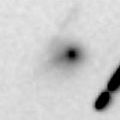
|
An outburst occured in late May and it brightened up to 14.6 mag (May 23, Gustavo Muler), but it faded down to the original brightness in late May. Then it had been reported so faint as 17 mag by CCD observations. However, it suddenly became so bright and visible visually after late August, and it reached up to 11.0 mag visually in September (Sept. 24, Juan Jose Gonzalez). However, it is fading now. It locates extremely low in the Northern Hemisphere.
Date(TT) R.A. (2000) Decl. Delta r Elong. m1 Best Time(A, h)
Dec. 13 20 17.43 -32 21.1 2.178 1.553 39 14.9 18:19 ( 42, 7)
Dec. 20 20 42.98 -31 35.6 2.250 1.600 38 15.1 18:22 ( 44, 7)
|
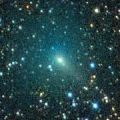
|
Diffuse comet, but it brightened up to 9.8 mag on July 7 (Juan Jose Gonzalez). Now it is fading, but still visible visually at 14.1 mag (Nov. 22, Seiichi Yoshida). In the Northern Hemisphere, it keeps observable until 2009 spring when the comet becomes faint. It will move near by the Northern Pole from summer to autumn, and will be observable all night. It will be visible visually for some more time. In the Southern Hemisphere, it will never be observable again.
Date(TT) R.A. (2000) Decl. Delta r Elong. m1 Best Time(A, h)
Dec. 13 2 0.53 70 35.5 1.883 2.571 124 15.2 20:31 (180, 55)
Dec. 20 2 8.82 66 57.2 1.947 2.632 124 15.6 20:12 (180, 58)
|

|
Now it is 15.8 mag (Dec. 5, Ken-ichi Kadota). It should have reached up to 13.5 mag in summer in the southern sky, but it is already fading. In the Southern Hemisphere, it keeps observable for a long time after this. It is finally appearing in the morning sky also in the Northern Hemisphere soon. It keeps observable while the comet will be fading slowly after this.
Date(TT) R.A. (2000) Decl. Delta r Elong. m1 Best Time(A, h)
Dec. 13 12 15.34 -29 1.0 3.453 3.214 67 15.3 5:28 (341, 23)
Dec. 20 12 18.33 -28 42.9 3.396 3.259 73 15.3 5:32 (348, 25)
|
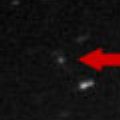
|
Now it is 15.2 mag (Nov. 23, J. F. Hernandez). It will be getting lower in the evening sky, and it will be unobservable in December.
Date(TT) R.A. (2000) Decl. Delta r Elong. m1 Best Time(A, h)
Dec. 13 19 33.31 -15 57.2 2.566 1.805 31 15.3 18:19 ( 61, 11)
Dec. 20 19 52.84 -15 33.4 2.582 1.790 29 15.4 18:22 ( 63, 9)
|
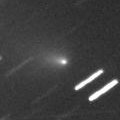
|
It had been lost for 112 years sincd 1896, but re-discovered by Koichi Itagaki and Hiroshi Kaneda on Sept. 10. It should be bright temporarily in outburst now. However, it became somewhat brighter in November than October. It still keeps bright as 12.6 mag (Nov. 22, Seiichi Yoshida). It keeps locating high in the evening sky for a while after this. It will keep visible visually for some more time.
Date(TT) R.A. (2000) Decl. Delta r Elong. m1 Best Time(A, h)
Dec. 13 23 54.11 -10 34.2 1.457 1.803 93 15.5 18:25 ( 0, 45)
Dec. 20 0 8.87 -9 28.7 1.557 1.840 89 15.9 18:22 ( 3, 46)
|

|
Now it is 16.5 mag (Nov. 26, Ken-ichi Kadota). It will be observable at 15 mag in good condition in winter.
Date(TT) R.A. (2000) Decl. Delta r Elong. m1 Best Time(A, h)
Dec. 13 9 47.58 19 53.8 3.069 3.645 118 15.7 4:20 ( 0, 75)
Dec. 20 9 47.98 20 9.3 2.977 3.640 125 15.6 3:53 ( 0, 75)
|
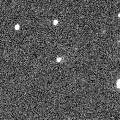
|
Now it is 16.0 mag (Nov. 21, Ken-ichi Kadota). It will brighten up to 12-13 mag in 2010 summer. It reaches to 14.5 mag in 2009 spring, and keeps observable in good condition until 2009 summer.
Date(TT) R.A. (2000) Decl. Delta r Elong. m1 Best Time(A, h)
Dec. 13 12 17.58 9 20.2 3.451 3.439 81 15.9 5:28 (319, 58)
Dec. 20 12 23.00 9 4.2 3.329 3.418 86 15.8 5:32 (331, 61)
|
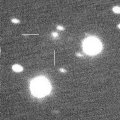
|
Now it is 16.2 mag (Oct. 27, Gustavo Muler). It will be observable at 16 mag in good condition from autumn to winter.
Date(TT) R.A. (2000) Decl. Delta r Elong. m1 Best Time(A, h)
Dec. 13 1 57.74 26 35.0 1.656 2.444 133 15.9 20:28 ( 0, 82)
Dec. 20 1 59.00 26 4.8 1.704 2.430 127 15.9 20:02 ( 0, 81)
|
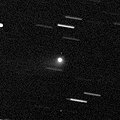
|
Now it is 14.2 mag and visible visually (Nov. 22, Seiichi Yoshida). But it starts fading in December, and will get lower in the evening sky in January.
Date(TT) R.A. (2000) Decl. Delta r Elong. m1 Best Time(A, h)
Dec. 13 0 6.29 13 42.2 3.148 3.539 105 16.0 18:36 ( 0, 69)
Dec. 20 23 59.77 12 59.2 3.310 3.562 96 16.1 18:22 ( 13, 68)
|
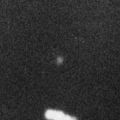
|
Now it is 15.5 mag (Oct. 18, Yasukazu Ikari). It will be too low in the evening sky in January. In 2009, it will be observable at 15 mag in good condition for a long time from summer to autumn.
Date(TT) R.A. (2000) Decl. Delta r Elong. m1 Best Time(A, h)
Dec. 13 22 53.68 -30 46.4 4.533 4.342 72 16.2 18:19 ( 13, 23)
Dec. 20 22 55.46 -29 7.8 4.606 4.317 66 16.2 18:22 ( 20, 23)
|
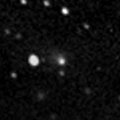
|
Now it is 14.6 mag and visible visually (Aug. 6, Juan Jose Gonzalez). It locates somewhat low in the Northern Hemisphere, but it keeps observable around 15-16 mag until winter.
Date(TT) R.A. (2000) Decl. Delta r Elong. m1 Best Time(A, h)
Dec. 13 21 52.04 -16 1.1 3.111 2.814 63 16.2 18:19 ( 34, 32)
Dec. 20 22 1.05 -14 48.2 3.190 2.810 58 16.3 18:22 ( 39, 31)
|
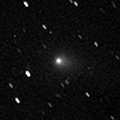
|
It passed near by earth in October. It brightened more rapidly than expected, and then it continues brightening more. Now it is bright as 13.7 mag and visible visually (Nov. 24, Marco Goiato). However, it will fade out rapidly after this. It will be fainter than 18 mag in late December.
Date(TT) R.A. (2000) Decl. Delta r Elong. m1 Best Time(A, h)
Dec. 13 3 8.24 18 47.0 0.577 1.507 148 16.3 21:38 ( 0, 74)
Dec. 20 3 15.07 19 40.2 0.633 1.538 143 16.8 21:18 ( 0, 75)
|
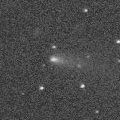
|
Now it is 13.9 mag and visible visually (Nov. 1, Seiichi Yoshida). It will be fading slowly after this. But it keeps observable in good condition until February when it becomes fainter than 18 mag.
Date(TT) R.A. (2000) Decl. Delta r Elong. m1 Best Time(A, h)
Dec. 13 3 5.64 7 24.1 1.366 2.237 143 16.3 21:35 ( 0, 62)
Dec. 20 3 5.17 7 41.5 1.434 2.255 136 16.5 21:07 ( 0, 63)
|
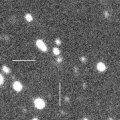
|
Now it is 15.8 mag (Nov. 23, I. Almendros). It will be fading slowly after this, and will be fainter than 18 mag in March.
Date(TT) R.A. (2000) Decl. Delta r Elong. m1 Best Time(A, h)
Dec. 13 20 58.70 26 34.0 1.980 1.924 72 16.3 18:19 ( 89, 53)
Dec. 20 21 18.62 27 23.7 2.017 1.936 71 16.4 18:22 ( 92, 51)
|

|
At the discovery in 2001, it became much brighter after the perihelion passage. In this apparition, although it was so faint as 20 mag in early September, it has already brightened rapidly up to 17.9 mag (Nov. 23, D. T. Durig, M. H. McManus). It will reach up to 16 mag in January, and will be observable in good condition.
Date(TT) R.A. (2000) Decl. Delta r Elong. m1 Best Time(A, h)
Dec. 13 8 37.74 17 50.2 1.123 1.940 134 16.6 3:10 ( 0, 73)
Dec. 20 8 39.83 18 20.2 1.078 1.942 140 16.4 2:45 ( 0, 73)
|

|
Now it is 17.6 mag (Nov. 23, Catalina Sky Survey). It will be observable at 15 mag in good condition in 2009 spring.
Date(TT) R.A. (2000) Decl. Delta r Elong. m1 Best Time(A, h)
Dec. 13 12 13.27 17 45.0 2.562 2.674 85 17.1 5:28 (310, 66)
Dec. 20 12 20.26 17 4.0 2.453 2.653 90 16.9 5:32 (324, 69)
|

|
Now it is 17.4 mag (Sept. 9, Ken-ichi Kadota). It will brighten up to 12 mag in 2012. It is faint still in 2008, but observable at 17 mag in good condition.
Date(TT) R.A. (2000) Decl. Delta r Elong. m1 Best Time(A, h)
Dec. 13 22 36.20 2 50.4 10.090 9.978 80 17.0 18:19 ( 32, 54)
Dec. 20 22 36.06 2 43.2 10.173 9.941 73 17.0 18:22 ( 42, 50)
|
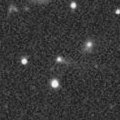
|
It brightened rapidly, and reached to the maximum after the perihelion passage. It was visible visually at 14.8 mag on Sept. 29 (Juan Jose Gonzalez). Now it is fading. It will be fainter than 18 mag in January.
Date(TT) R.A. (2000) Decl. Delta r Elong. m1 Best Time(A, h)
Dec. 13 1 5.95 6 52.7 1.932 2.531 116 17.1 19:36 ( 0, 62)
Dec. 20 1 11.67 6 14.9 2.038 2.555 110 17.3 19:15 ( 0, 61)
|
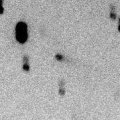
|
Now it is 16.4 mag (Nov. 2, L. Montoro). It brightened rapidly and became brighter than expected. However, it will start fading after December, and will be fainter than 18 mag in January.
Date(TT) R.A. (2000) Decl. Delta r Elong. m1 Best Time(A, h)
Dec. 13 1 45.48 26 22.5 0.952 1.763 131 17.1 20:16 ( 0, 81)
Dec. 20 1 53.38 26 11.6 1.011 1.778 126 17.3 19:56 ( 0, 81)
|
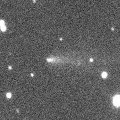
|
It was visible visually at 14.0 mag in autumn (Sept. 7, Juan Jose Gonzalez). Now it is fading, but it keeps observable in good condition until it fades out in winter. Now it is 15.0 mag (Nov. 1, Ken-ichi Kadota), still bright unexpectedly. Maybe a small outburst occured.
Date(TT) R.A. (2000) Decl. Delta r Elong. m1 Best Time(A, h)
Dec. 13 4 9.42 18 57.5 1.386 2.344 162 17.1 22:39 ( 0, 74)
Dec. 20 4 4.67 19 7.1 1.458 2.384 154 17.4 22:06 ( 0, 74)
|

|
Peculiar asteroid moving along a cometary orbit. It will be observable around 17 mag in good condition for a long time until May. It will fade out very rapidly after May.
Date(TT) R.A. (2000) Decl. Delta r Elong. m1 Best Time(A, h)
Dec. 13 12 48.86 3 34.2 1.505 1.516 71 17.4 5:28 (314, 49)
Dec. 20 13 5.63 2 9.2 1.482 1.541 74 17.4 5:32 (320, 50)
|
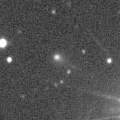
|
It was observed as bright as 14-15 mag in 2007 autumn. Now it is 17.8 mag (Oct. 26, Catalina Sky Survey). It keeps observable in good condition for a while. It will be fainter than 18 mag in Feburary.
Date(TT) R.A. (2000) Decl. Delta r Elong. m1 Best Time(A, h)
Dec. 13 8 21.37 32 48.7 2.646 3.454 139 17.5 2:54 ( 0, 88)
Dec. 20 8 17.49 33 10.5 2.614 3.480 146 17.5 2:23 ( 0, 88)
|

|
It keeps observable in good condition at 17.5-18 mag until March.
Date(TT) R.A. (2000) Decl. Delta r Elong. m1 Best Time(A, h)
Dec. 13 5 16.93 3 57.3 1.585 2.535 160 17.5 23:46 ( 0, 59)
Dec. 20 5 10.82 4 40.8 1.577 2.519 158 17.5 23:12 ( 0, 60)
|
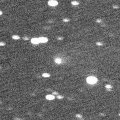
|
It was observed at 16.5-17 mag in 2007 autumn. Now it is 17.3 mag (July 2, J. F. Hernandez). It will be fading after this, and will be fainter than 18 mag at the end of 2008.
Date(TT) R.A. (2000) Decl. Delta r Elong. m1 Best Time(A, h)
Dec. 13 4 30.16 26 39.7 2.014 2.983 167 17.6 22:59 ( 0, 82)
Dec. 20 4 24.66 26 12.6 2.070 3.013 159 17.8 22:26 ( 0, 81)
|
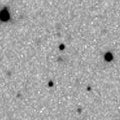
|
Although it was extremely faint as 20 mag in June, it brightened much faster than expected and reached up to 17.1 mag (Oct. 30, P. C. Sherrod). However, it will fade out rapidly after this, and will be fainter than 18 mag in January.
Date(TT) R.A. (2000) Decl. Delta r Elong. m1 Best Time(A, h)
Dec. 13 0 42.01 11 8.7 2.821 3.327 112 17.6 19:12 ( 0, 66)
Dec. 20 0 45.26 10 57.6 2.922 3.334 106 17.7 18:48 ( 0, 66)
|

|
It keeps observable at 17.5-18 mag until February. But it is moving southwards, and getting lower in the Northern Hemisphere.
Date(TT) R.A. (2000) Decl. Delta r Elong. m1 Best Time(A, h)
Dec. 13 12 22.16 5 17.6 2.026 2.066 78 17.7 5:28 (321, 54)
Dec. 20 12 21.90 2 23.7 1.955 2.100 84 17.7 5:32 (336, 55)
|

|
Now it should be brightest. But it has not been recovered yet. It was observed only around the perihelion at the discovery in 1999. If it was bright temporarily in outburst, it can be much fainter than this ephemeris in this apparition. Josef Mueller reported it was 19.2 mag on Dec. 16, 2007, but it was not confirmed.
Date(TT) R.A. (2000) Decl. Delta r Elong. m1 Best Time(A, h)
Dec. 13 6 32.40 24 48.6 2.350 3.307 163 17.7 1:06 ( 0, 80)
Dec. 20 6 27.27 24 43.8 2.331 3.308 172 17.7 0:33 ( 0, 80)
|

|
It reached up to 16 mag last winter. Now it is 17.7 mag (Nov. 19, Ken-ichi Kadota). It will be fainter than 18 mag in late December.
Date(TT) R.A. (2000) Decl. Delta r Elong. m1 Best Time(A, h)
Dec. 13 4 30.52 20 2.3 5.041 6.007 167 17.8 23:00 ( 0, 75)
Dec. 20 4 26.32 20 26.7 5.110 6.042 159 17.9 22:28 ( 0, 75)
|
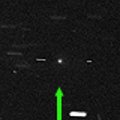
|
Now it is 17.5 mag (Nov. 5, Ken-ichi Kadota). It will be fainter than 18 mag in late December.
Date(TT) R.A. (2000) Decl. Delta r Elong. m1 Best Time(A, h)
Dec. 13 1 26.77 8 47.0 1.848 2.513 122 17.8 19:57 ( 0, 64)
Dec. 20 1 29.28 9 21.8 1.923 2.512 115 17.9 19:32 ( 0, 64)
|
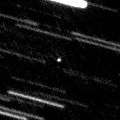
|
Origin of Geminids meteor shower. It is observable in good condition at 17.5 mag from November to December.
Date(TT) R.A. (2000) Decl. Delta r Elong. m1 Best Time(A, h)
Dec. 13 1 58.69 30 57.6 1.480 2.281 134 17.9 20:28 ( 0, 86)
Dec. 20 1 50.02 28 57.7 1.534 2.256 125 18.0 19:52 ( 0, 84)
|
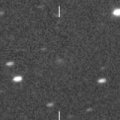
|
Now it is 17.5-18.0 mag (Nov. 9, Michael Jager). It keeps observable at 18 mag in good condition until February.
Date(TT) R.A. (2000) Decl. Delta r Elong. m1 Best Time(A, h)
Dec. 13 11 24.62 31 10.8 2.056 2.446 101 17.9 5:28 (301, 83)
Dec. 20 11 31.86 31 53.1 2.006 2.470 106 17.9 5:32 (345, 87)
|

|
Great outburst occured in 2007 October, and it bacame a naked eye comet of 2 mag. It kept so bright as 5.5 mag still in 2008 spring (Apr. 30, Carlos Labordena), but it was extremely faint and difficult to see. The size was so large, the diameter was larger than 60 arcmin. It will become observable in good condition in this autumn and winter again. The extremely faint large diffuse glow may be detected with a best sky condition, around 5-6 mag with a diameter of 1 or 2 degrees. Mitsunori Tsumura detected a possible glow of Comet Holmes on Nov. 4. Current brightness of the central core is 17.8 mag (Oct. 31, Ken-ichi Kadota), much brighter than pre-outburst brightness still now.
Date(TT) R.A. (2000) Decl. Delta r Elong. m1 Best Time(A, h)
Dec. 13 9 19.08 25 36.7 3.437 4.099 126 18.4 3:52 ( 0, 81)
Dec. 20 9 16.35 25 46.5 3.377 4.122 133 18.4 3:22 ( 0, 81)
|
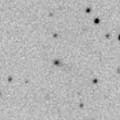
|
It was observed bright at 16.5-17 mag from late 2006 to early 2007. However, it is fading after that, although it is getting closer to the sun. It was so faint as 19.4 mag around the perihelion passage in 2008 spring (Mar. 10, Mitsunori Tsumura). This comet was observed so faint around the perihelion passage in the previous apparition at the discovery. It faded out before the perihelion passage again in this apparition.
Date(TT) R.A. (2000) Decl. Delta r Elong. m1 Best Time(A, h)
Dec. 13 11 43.13 17 15.0 4.158 4.307 92 21.6 5:28 (326, 69)
Dec. 20 11 46.63 17 26.3 4.061 4.313 98 21.5 5:32 (345, 72)
|
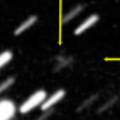
|
It was predicted to be so bright as 14 mag from spring to summer in 2008. But actually, it was extremely faint as 19.5 mag (Aug. 4, Gustavo Muler). Although it locates in good condition, it will be hard to observe.
Date(TT) R.A. (2000) Decl. Delta r Elong. m1 Best Time(A, h)
Dec. 13 22 47.08 10 0.7 3.294 3.372 86 21.8 18:19 ( 33, 61)
Dec. 20 22 54.30 10 11.7 3.445 3.431 80 21.9 18:22 ( 43, 59)
|
|
![]()
 210P/2008 X4 ( Christensen )
210P/2008 X4 ( Christensen ) C/2008 A1 ( McNaught )
C/2008 A1 ( McNaught ) C/2006 W3 ( Christensen )
C/2006 W3 ( Christensen ) 144P/Kushida
144P/Kushida C/2006 OF2 ( Broughton )
C/2006 OF2 ( Broughton ) C/2007 G1 ( LINEAR )
C/2007 G1 ( LINEAR ) 6P/d'Arrest
6P/d'Arrest C/2006 Q1 ( McNaught )
C/2006 Q1 ( McNaught ) C/2007 Q3 ( Siding Spring )
C/2007 Q3 ( Siding Spring ) 29P/Schwassmann-Wachmann 1
29P/Schwassmann-Wachmann 1 C/2008 T2 ( Cardinal )
C/2008 T2 ( Cardinal ) 19P/Borrelly
19P/Borrelly 116P/Wild 4
116P/Wild 4 67P/Churyumov-Gerasimenko
67P/Churyumov-Gerasimenko 22P/Kopff
22P/Kopff C/2007 B2 ( Skiff )
C/2007 B2 ( Skiff ) C/2005 L3 ( McNaught )
C/2005 L3 ( McNaught ) 7P/Pons-Winnecke
7P/Pons-Winnecke C/2008 J1 ( Boattini )
C/2008 J1 ( Boattini ) C/2006 U6 ( Spacewatch )
C/2006 U6 ( Spacewatch ) 68P/Klemola
68P/Klemola 205P/2008 R6 ( Giacobini )
205P/2008 R6 ( Giacobini ) 74P/Smirnova-Chernykh
74P/Smirnova-Chernykh 65P/Gunn
65P/Gunn 59P/Kearns-Kwee
59P/Kearns-Kwee C/2007 U1 ( LINEAR )
C/2007 U1 ( LINEAR ) C/2008 P1 ( Garradd )
C/2008 P1 ( Garradd ) 47P/Ashbrook-Jackson
47P/Ashbrook-Jackson P/2008 Q2 ( Ory )
P/2008 Q2 ( Ory ) 61P/Shajn-Schaldach
61P/Shajn-Schaldach C/2008 R3 ( LINEAR )
C/2008 R3 ( LINEAR ) 204P/2008 R5 ( LINEAR-NEAT )
204P/2008 R5 ( LINEAR-NEAT ) 77P/Longmore
77P/Longmore C/2006 S3 ( LONEOS )
C/2006 S3 ( LONEOS ) P/2008 L2 ( Hill )
P/2008 L2 ( Hill ) P/2008 QP20 ( LINEAR-Hill )
P/2008 QP20 ( LINEAR-Hill ) 51P/Harrington
51P/Harrington 2001 TX16
2001 TX16 188P/2007 J7 ( LINEAR-Mueller )
188P/2007 J7 ( LINEAR-Mueller ) P/2008 X1 ( Hill )
P/2008 X1 ( Hill ) 44P/Reinmuth 2
44P/Reinmuth 2 200P/2008 L1 ( Larsen )
200P/2008 L1 ( Larsen ) C/2008 X3 ( LINEAR )
C/2008 X3 ( LINEAR ) P/1999 XN120 ( Catalina )
P/1999 XN120 ( Catalina ) C/2006 K1 ( McNaught )
C/2006 K1 ( McNaught ) P/2008 T4 ( Hill )
P/2008 T4 ( Hill ) (3200) Phaethon
(3200) Phaethon 33P/Daniel
33P/Daniel 17P/Holmes
17P/Holmes 173P/2005 T1 ( Mueller 5 )
173P/2005 T1 ( Mueller 5 ) C/2007 K3 ( Siding Spring )
C/2007 K3 ( Siding Spring )![]()








































